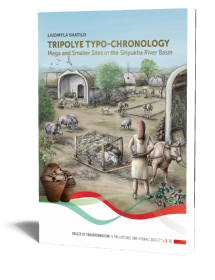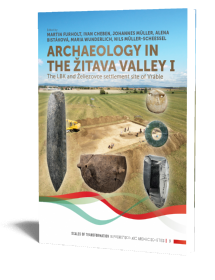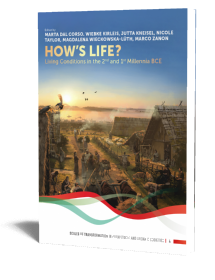Millet and What Else?
The Wider Context of the Adoption of Millet Cultivation in Europe
Edited by Wiebke Kirleis, Marta Dal Corso & Dragana Filipović | 2022
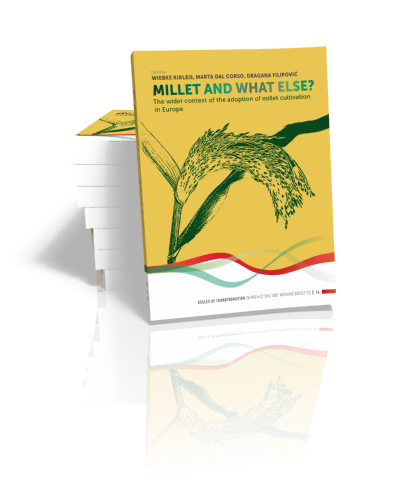
Millet and What Else?
The Wider Context of the Adoption of Millet Cultivation in Europe
Edited by Wiebke Kirleis, Marta Dal Corso & Dragana Filipović | 2022
Paperback ISBN: 9789464270150 | Hardback ISBN: 9789464270167 | Imprint: Sidestone Press Academics | Format: 210x280mm | 328 pp. | Scales of Transformation 14 | Series: Scales of Transformation | Language: English | 13 illus. (bw) | 61 illus. (fc) | Keywords: archaeology; millet; Europe prehistory; Bronze Age; archaeobotany; zooarchaeology; miliacin; prehistoric agriculture | download cover | DOI: 10.59641/o7235ra
Read online or downloaded 1703 times
-
Digital & Online access
This is a full Open Access publication, click below to buy in print, browse, or download for free.
-
Buy via Sidestone (EU & UK)
-
Buy via our Distributors (WORLD)
For non-EU or UK destinations you can buy our books via our international distributors. Although prices may vary this will ensure speedy delivery and reduction in shipping costs or import tax. But you can also order with us directly via the module above.
UK international distributor
USA international distributor
-
Bookinfo
Paperback ISBN: 9789464270150 | Hardback ISBN: 9789464270167 | Imprint: Sidestone Press Academics | Format: 210x280mm | 328 pp. | Scales of Transformation 14 | Series: Scales of Transformation | Language: English | 13 illus. (bw) | 61 illus. (fc) | Keywords: archaeology; millet; Europe prehistory; Bronze Age; archaeobotany; zooarchaeology; miliacin; prehistoric agriculture | download cover | DOI: 10.59641/o7235ra
Read online or downloaded 1703 times

We will plant a tree for each order containing a paperback or hardback book via OneTreePlanted.org.
Broomcorn/common/proso millet (Panicum miliaceum) is a cereal crop that originated in East Asia and was transferred westward to Europe, where it was introduced in the mid-2nd millennium BCE, at the height of the Bronze Age. Archaeobotanists from the Collaborative Research Centre 1266, supported by many colleagues, conducted a large-scale programme of radiocarbon dating of millet grains from prehistoric Europe. They discovered that the spread of this crop on the continent happened quickly, extending far and wide.
What do we know about the (pre)history of this crop in Europe? The workshop organised by the CRC 1266 at Kiel University in 2019 encouraged the discussion on the circumstances and consequences of early broomcorn millet cultivation in Europe. This book brings together many of the workshop papers and reflects the diverse topics and research areas covered. The contributions inform us on the range of cultivated and collected plants from the time before and after the start of millet cultivation in Europe; present the cultural setting in which millet arrived; discuss possible reasons driving the acceptance of this innovation; and reconstruct possible uses of millet and the methods of its cultivation, processing and storage. Not just the plant economy, but also the animal economy is represented, since millet was and is grown for both humans and animals. Techniques used to trace millet archaeologically are continually being developed or improved, and this book describes the application of a few of them.
This broad-based compilation of papers adds another layer to the dynamic picture of the Bronze Age and the interconnected continent. It also illustrates the complexity of the research on the diffusion of agricultural innovations.
Millet and what else? The wider context of the adoption of millet cultivation in Europe
Wiebke Kirleis, Dragana Filipović, Marta Dal Corso
PART 1: Innovations in the Bronze Age Subsistence Economy: Regional Perspectives from Ukraine to France
The (pre)history of common millet (Panicum miliaceum) in Ukraine and its place in the traditional cuisine
Galyna Pashkevych
Bronze Age plant spectra in Hungary before and after the introduction of millet cultivation
Sofia Filatova
Bronze Age novelties in animal exploitation in the Carpathian Basin in a European context
Lásló Bartosiewicz
Unearthing millet in Bronze and Iron Age Croatia
Kelly Reed, Jacqueline Balen, Ivan Drnić, Sara Essert, Hrvoje Kalafatić, Marija Mihaljević, Emily Zavodny
The earliest finds of millet and possible associated changes in material culture in Slovenia
Tjaša Tolar and Primož Pavlin
On the ‘ancient’ evidence for Panicum miliaceum and Vicia faba in central Germany (primarily Saxony-Anhalt)
Monika Hellmund
Millets in Bronze Age agriculture and food consumption in northeastern France
Françoise Toulemonde, Julian Wiethold, Emmanuelle Bonnaire, Geneviève Daoulas, Marie Derreumaux, Frédérique Durand, Bénédicte Pradat, Oriane Rousselet, Caroline Schaal, Véronique Zech-Matterne
Onsite to offsite: A multidisciplinary and multiscale consideration of the 13th to 11th century BCE transformation in northern Germany
Ingo Feeser, Stefanie Schaefer-Di Maida, Stefan Dreibrodt, Jutta Kneisel, Dragana Filipović
PART 2: Approaching Millet Cultivation and Consumption through High-end Microscopy, Chemistry and Ethnography
Putting millet into a culinary context: Organic residue analysis and the identification of Panicum miliaceum in pottery vessels
Edward A. Standall, Oliver E. Craig, Carl Heron
Exploiting the feasibility of biomarker analysis in alluvial contexts: The first miliacin evidence from the northern Italian Bronze Age
Marta Dal Corso, Marco Zanon, Carl Heron, Mauro Rottoli, Michele Cupitò, Elisa Dalla Longa, Wiebke Kirleis
Exploring seed impressions within the fabric of pottery: Using a silicone cast method for reliable identification
Eiko Endo
Traditional millet cultivation in the Iberian Peninsula: Ethnoarchaeological reflections through the lens of social relations and economic concerns
Andrés Teira-Brión
Versatile usage of millet: brooms and animal fodder from Sorghum technicum
Wiebke Kirleis and Marta Dal Corso
Early cultivation of millet in Europe: what else and where next? Concluding the workshop proceedings
Dragana Filipović, Marta Dal Corso, Wiebke Kirleis
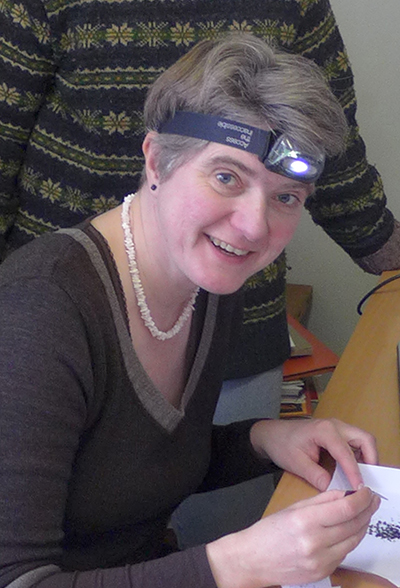
Prof. Dr. Wiebke Kirleis
Wiebke Kirleis is professor of environmental archaeology/archaeobotany at Kiel University, Germany. She is deputy director of the Collaborative Research Centre ‘Scales of Transformation: Human–Environmental Interaction in Prehistoric and Archaic Societies’ (CRC 1266, financed by the German Research Foundation/DFG) and a member of the Cluster of Excellence ‘Roots’ at Kiel University.
Dr. Marta Dal Corso
Marta Dal Corso is a postdoctoral researcher in the field of archaeobotany and palynology, interested in the understanding of plant cultivation and use in prehistory and of the relationships between human activities and natural environments. She is currently working at the Institute for Prehistoric and Protohistoric Archaeology at Kiel University (Germany), where she has been assistant to the chair of Environmental Archaeology and taught palynology and phytolith analysis among other classes.
Dr. Dragana Filipović
Dragana Filipović is currently a member of the Collaborative Research Centre 1266 at the Institute for Prehistoric and Protohistoric Archaeology, Kiel University (Germany). There she carries out archaeobotanical investigations, including the analysis of plant remains from Neolithic and Bronze Age sites in central and northern Europe. She coordinated the Millet Dating Programme of the CRC 1266. Her main field of interest is the social, technological and environmental context of plant production and consumption in the past. She has been involved in a number of international research projects (including the Çatalhöyük Research Project and several ERC-funded programmes) and excavations in Turkey, Serbia, Portugal, Slovakia and Germany.
Abstract:
Broomcorn/common/proso millet (Panicum miliaceum) is a cereal crop that originated in East Asia and was transferred westward to Europe, where it was introduced in the mid-2nd millennium BCE, at the height of the Bronze Age. Archaeobotanists from the Collaborative Research Centre 1266, supported by many colleagues, conducted a large-scale programme of radiocarbon dating of millet grains from prehistoric Europe. They discovered that the spread of this crop on the continent happened quickly, extending far and wide.
What do we know about the (pre)history of this crop in Europe? The workshop organised by the CRC 1266 at Kiel University in 2019 encouraged the discussion on the circumstances and consequences of early broomcorn millet cultivation in Europe. This book brings together many of the workshop papers and reflects the diverse topics and research areas covered. The contributions inform us on the range of cultivated and collected plants from the time before and after the start of millet cultivation in Europe; present the cultural setting in which millet arrived; discuss possible reasons driving the acceptance of this innovation; and reconstruct possible uses of millet and the methods of its cultivation, processing and storage. Not just the plant economy, but also the animal economy is represented, since millet was and is grown for both humans and animals. Techniques used to trace millet archaeologically are continually being developed or improved, and this book describes the application of a few of them.
This broad-based compilation of papers adds another layer to the dynamic picture of the Bronze Age and the interconnected continent. It also illustrates the complexity of the research on the diffusion of agricultural innovations.
Contents
Millet and what else? The wider context of the adoption of millet cultivation in Europe
Wiebke Kirleis, Dragana Filipović, Marta Dal Corso
PART 1: Innovations in the Bronze Age Subsistence Economy: Regional Perspectives from Ukraine to France
The (pre)history of common millet (Panicum miliaceum) in Ukraine and its place in the traditional cuisine
Galyna Pashkevych
Bronze Age plant spectra in Hungary before and after the introduction of millet cultivation
Sofia Filatova
Bronze Age novelties in animal exploitation in the Carpathian Basin in a European context
Lásló Bartosiewicz
Unearthing millet in Bronze and Iron Age Croatia
Kelly Reed, Jacqueline Balen, Ivan Drnić, Sara Essert, Hrvoje Kalafatić, Marija Mihaljević, Emily Zavodny
The earliest finds of millet and possible associated changes in material culture in Slovenia
Tjaša Tolar and Primož Pavlin
On the ‘ancient’ evidence for Panicum miliaceum and Vicia faba in central Germany (primarily Saxony-Anhalt)
Monika Hellmund
Millets in Bronze Age agriculture and food consumption in northeastern France
Françoise Toulemonde, Julian Wiethold, Emmanuelle Bonnaire, Geneviève Daoulas, Marie Derreumaux, Frédérique Durand, Bénédicte Pradat, Oriane Rousselet, Caroline Schaal, Véronique Zech-Matterne
Onsite to offsite: A multidisciplinary and multiscale consideration of the 13th to 11th century BCE transformation in northern Germany
Ingo Feeser, Stefanie Schaefer-Di Maida, Stefan Dreibrodt, Jutta Kneisel, Dragana Filipović
PART 2: Approaching Millet Cultivation and Consumption through High-end Microscopy, Chemistry and Ethnography
Putting millet into a culinary context: Organic residue analysis and the identification of Panicum miliaceum in pottery vessels
Edward A. Standall, Oliver E. Craig, Carl Heron
Exploiting the feasibility of biomarker analysis in alluvial contexts: The first miliacin evidence from the northern Italian Bronze Age
Marta Dal Corso, Marco Zanon, Carl Heron, Mauro Rottoli, Michele Cupitò, Elisa Dalla Longa, Wiebke Kirleis
Exploring seed impressions within the fabric of pottery: Using a silicone cast method for reliable identification
Eiko Endo
Traditional millet cultivation in the Iberian Peninsula: Ethnoarchaeological reflections through the lens of social relations and economic concerns
Andrés Teira-Brión
Versatile usage of millet: brooms and animal fodder from Sorghum technicum
Wiebke Kirleis and Marta Dal Corso
Early cultivation of millet in Europe: what else and where next? Concluding the workshop proceedings
Dragana Filipović, Marta Dal Corso, Wiebke Kirleis

Prof. Dr. Wiebke Kirleis
Wiebke Kirleis is professor of environmental archaeology/archaeobotany at Kiel University, Germany. She is deputy director of the Collaborative Research Centre ‘Scales of Transformation: Human–Environmental Interaction in Prehistoric and Archaic Societies’ (CRC 1266, financed by the German Research Foundation/DFG) and a member of the Cluster of Excellence ‘Roots’ at Kiel University.
Dr. Marta Dal Corso
Marta Dal Corso is a postdoctoral researcher in the field of archaeobotany and palynology, interested in the understanding of plant cultivation and use in prehistory and of the relationships between human activities and natural environments. She is currently working at the Institute for Prehistoric and Protohistoric Archaeology at Kiel University (Germany), where she has been assistant to the chair of Environmental Archaeology and taught palynology and phytolith analysis among other classes.
Dr. Dragana Filipović
Dragana Filipović is currently a member of the Collaborative Research Centre 1266 at the Institute for Prehistoric and Protohistoric Archaeology, Kiel University (Germany). There she carries out archaeobotanical investigations, including the analysis of plant remains from Neolithic and Bronze Age sites in central and northern Europe. She coordinated the Millet Dating Programme of the CRC 1266. Her main field of interest is the social, technological and environmental context of plant production and consumption in the past. She has been involved in a number of international research projects (including the Çatalhöyük Research Project and several ERC-funded programmes) and excavations in Turkey, Serbia, Portugal, Slovakia and Germany.
-
Digital & Online access
This is a full Open Access publication, click below to buy in print, browse, or download for free.
-
Buy via Sidestone (EU & UK)
-
Buy via our Distributors (WORLD)
For non-EU or UK destinations you can buy our books via our international distributors. Although prices may vary this will ensure speedy delivery and reduction in shipping costs or import tax. But you can also order with us directly via the module above.
UK international distributor
USA international distributor
- Browse all books by subject
-
Search all books

We will plant a tree for each order containing a paperback or hardback book via OneTreePlanted.org.
You might also like:
© 2025 Sidestone Press KvK nr. 28114891 Privacy policy Sidestone Newsletter Terms and Conditions (Dutch)
